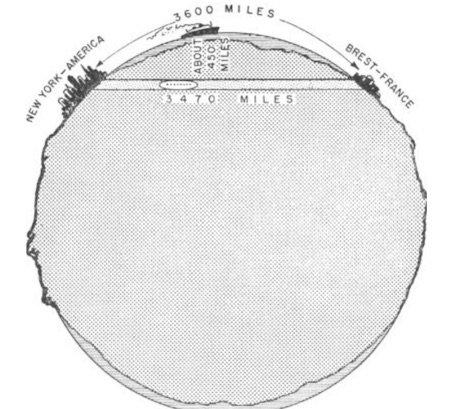Science Fiction
Dictionary
A B C D E F G H I J K L M N O P Q R S T U V W X Y Z
Latest By
Category:
Armor
Artificial
Intelligence
Biology
Clothing
Communication
Computers
Culture
Data Storage
Displays
Engineering
Entertainment
Food
Input Devices
Lifestyle
Living Space
Manufacturing
Material
Media
Medical
Miscellaneous
Robotics
Security
Space Tech
Spacecraft
Surveillance
Transportation
Travel
Vehicle
Virtual
Person
Warfare
Weapon
Work
"The planet's immune system is doing everything it can. The planet's immune system is doing everything it can."
- Kurt Vonnegut, Jr.
| Sub-Atlantic Tube | ||
| A tunnel under the ocean; the shortest distance between the two points. |
The first successful underwater tunnel was the Thames tunnel, completed in 1843, between between Rotherhithe and Wapping in London. It was 35 feet wide and 1,300 feet long.
The Chunnel between Britain and France, a 31 mile tunnel, is probably the closest thing to what Gernsbeck described. It was completed in 1994.
| "We had the honor of being the first passengers to arrive by means of the new Subatlantic Tube," said James... "...the tube runs in a straight line between New York and Brest, France. If it were to run straight along the bottom of the ocean the distance between the two points would be from 3600 to 3700 miles due to the curvature of the earth. For this reason the tube was pushed straight through the earth, thereby making the distance only 3470 miles..."
 (Sub-Atlantic Tunnel from 'Ralph 124c 41 +' by Hugo Gernsback) "...the greatest trouble ... our engineers experienced near the middle of the tube; this point is 450 miles nearer the center of the earth and the heat became very marked. It was necessary to install large liquid-air plants at several points in the tube to reduce the heat... "There are no wheels to the tube car and it is propelled by magnetism only. At each three hundred feet is stationed a powerful tubular electromagnet, about thirty feet long, through which the tube car passes... "As the car is held suspended entirely by magnetism, there is practically no friction whatever, as there are no wheels or rails." |
| Technovelgy from Ralph 124c 41 +,
by Hugo Gernsback. Published by Modern Electrics in 1911 Additional resources -
|
The car itself has the features of a Dewar flask (used in Thermos bottles); there is vacuum between two solid walls, which tends to keep heat transfer to a minimum. However, it does not appear that Gernsback figured out the best feature of this kind of arrangement; you could actually do this without any motive power at all, since the tube car would "fall" into the tunnel, dropping 450 miles, and then gradually "bounce" back up to the surface. There would be some loss due to air friction, but otherwise you would get the trip for free, from an energy standpoint.
For a discussion of this option, as well as the brachistochrone problem (a straight line tunnel isn't the most efficient), see gravity-assisted subway from Larry Niven's 1976 novel A World Out Of Time.
Compare to the single vehicle tunnel from Foundation (1951) by Isaac Asimov, the
pneumatic tube station from Exiles of the Moon (1931) by Schachner and Zagat, the
submarine tube from An Express of the Future (1895) by Jules Verne, the
vacutubes from Double Star (1956) by Robert Heinlein and the public tubes from The Houses of Iszm (1954) by Jack Vance.
Compare to the submarine tube from An Express of the Future (1895) by Michel Verne, the
air tunnel from Through the Air Tunnel (19129) by Harl Vincent, the
pneumatic tube station from Exiles of the Moon (1931) by Nat Schachner (w. AL Zagat), the
pneumatic-tube zone from Mechanocracy (1932) by Miles J. Breuer, the
vacuum cylinder from Wandl, The Invader (2839) by Ray Cummings, the
vortal tube from Whipping Star (1969) by Frank Herbert, the
public vehicle tube from The Houses of Iszm (1954) by Jack Vance, the
vacutubes from Double Star (1956) by Robert Heinlein and the
bounce tube from Double Star (1956) by Robert Heinlein.
Comment/Join this discussion ( 2 ) | RSS/XML | Blog This |
Additional
resources:
More Ideas
and Technology from Ralph 124c 41 +
More Ideas
and Technology by Hugo Gernsback
Tech news articles related to Ralph 124c 41 +
Tech news articles related to works by Hugo Gernsback
| SpaceX Rocket Shuttle Point-To-Point On Earth |
| CORLEO Robotic Horse Concept Looks Ready To Ride |
| Futuristic Transit Elevated Bus Never Really Worked |
| Japan Automated Cargo Transport |
Want to Contribute an
Item?
It's easy:
Get the name of the item, a
quote, the book's name and the author's name, and Add
it here.
| <Previous | Next> |
|
|
|
Technovelgy (that's tech-novel-gee!) is devoted to the creative science inventions and ideas of sf authors. Look for the Invention Category that interests you, the Glossary, the Science Fiction Invention Timeline, or see what's New.
|
Science Fiction
Timeline
1600-1899
1900-1939
1940's 1950's
1960's 1970's
1980's 1990's
2000's 2010's
'The leg was to function, in a way, as a servo-mechanism operated by Larry’s brain...'
'The observation vehicle was of that peculiar variety used in conveying a large number of people across rough terrain.'
'The real border was defended by... a swarm of quasi-independent aerostats.'
'I ... set my automatic astronomical instruments to searching for a habitable planet.'
'...haven't you a section of the factory where only robot labor is employed?'
